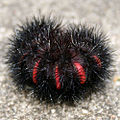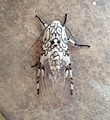Giant leopard moth
| Giant leopard moth | |
|---|---|

| |
| Scientific classification | |
| Domain: | Eukaryota |
| Kingdom: | Animalia |
| Phylum: | Arthropoda |
| Class: | Insecta |
| Order: | Lepidoptera |
| Superfamily: | Noctuoidea |
| Family: | Erebidae |
| Subfamily: | Arctiinae |
| Genus: | Hypercompe |
| Species: | H. scribonia
|
| Binomial name | |
| Hypercompe scribonia (Stoll, 1790)
| |
| Subspecies | |
| |
| Synonyms | |
| |
The giant leopard moth (Hypercompe scribonia) is a moth of the family Erebidae. They are distributed through North America from southern Ontario, and southern and eastern United States through New England, Mexico, and south to Colombia.[2][3] The obsolete name, Ecpantheria scribonia, is still occasionally encountered.
They are known to be attracted to bitter, unripe vegetables and broccoli flowers.
This moth species has a
nocturnal and do not generally fly before nightfall.[4]
This species has a notable sexual dimorphism in size, with the adult male reaching about 51 mm (2 in) in length, while the adult female grows up to 30 mm (1.2 in). In Missouri, adults are on the wing from May to September and are
multivoltine.[5] During mating sessions, the wings of the male cover most of the female's abdomen, which can sometimes lead to the loss of wing scales in the female and have negative effects on her flight efficiency.[6] Their mating sessions are notably long-lasting, taking more than 24 hours. They stay mostly immobile during the whole process, but move from spot to spot to thermoregulate
, walking into shadowy areas if too hot or into sunlight if too cold. The male effectuates the locomotion, while the female folds her legs to make her easier to carry.
The
overwinters as a caterpillar,[3] often under the bark of decaying wood.[5] The caterpillar grows to be 7.6 cm (3 in) long.[5]
Recorded food plants
The caterpillar eats a variety of broadleaf plants, such as
violets
:
|
Gallery
-
Larval stage
-
Caterpillar in typical defensive ball
-
Caterpillar with typical red stripes
-
Head of a caterpillar
-
Closeup of head and thorax
-
Closeup showing iridescent blue spots
-
Closeup of newly eclosed moth
-
Showing the old skin, empty pupal shell, and adult moth
-
Last image at night before it flew off once wings dried
-
Wings spread, displaying abdomen colors
-
Close-up while wings upswept
-
The moment before take-off
-
A female giant leopard moth after mating
-
A female taking off
References
- ^ Poole, Robert W.; Patricia Gentili (1996). "Hypercompe scribonia". NatureServe. Archived from the original on 10 December 2019. Retrieved 18 July 2013.
- ^ [1] Distribution map at DiscoverLife
- ^ a b c d e Fearnley, Kirstin (29 July 2016). "Weird & Wonderful Creatures: Giant Leopard Moth". Science NetLinks. American Association for the Advancement of Science. Retrieved 5 September 2022.
- ^ a b c d e f g h i j k "Field Guide: Giant Leopard Moth". Missouri Department of Conservation. Retrieved 5 September 2022.
- ISBN 978-0-19-854952-9.
External links
Wikimedia Commons has media related to Giant leopard moth.















